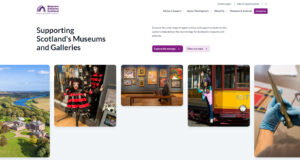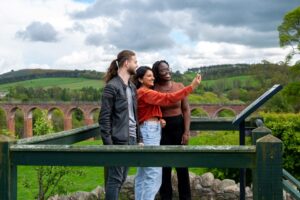Can you build values and inclusion into a website redevelopment?
Our Communications Team recently featured in the Culture Content Newsletter from One Further, reflecting on the process of creating a new website to help launch Scotland’s Museums and Galleries Strategy. The story outlines how the team set out to build a website that embedded our values in to the heart of the project, while keeping an inclusive and anti-racist mindset throughout. It features helpful tips to make your own website more inclusive.
Introduction
We needed a new website to host and support the next Scotland’s Museums and Galleries Strategy 2023 – 2030, which was due to launch in February 2023. It was important to us that this strategy didn’t become a “document for the shelf.” The ambition was to create a living, breathing, strategy for the full lifetime of its use. The strategy sets out a vision for Scottish museums and galleries to be accessible and inclusive to all. That vision is also a part of our own commitment to be an inclusive, anti-racist organisation. So there were high expectations on any website we built. This article takes you through our ongoing journey to embed those values into the content, design and structure of our new website.

Inclusive design
Several parts of the website design process led to greater inclusion across the site:
- Building from scratch is an efficient way to remove unconscious bias baked into an existing website. If you can’t build a new site, you can reduce that barrier by including inclusive prompts throughout your project. We use prompts developed Nuzhat Uthmani. Nuzhat is a Teacher and anti-racism educator who provided her expertise on the Empire, Slavery and Scotland’s Museums project.
- Find a developer who shares your values and will challenge your views. Questions about anti-racism, inclusion, climate, and accessibility were part of the tender process. They made sure our chosen developer, Primate, would be a critical friend, who we could trust and learn from.
- Think about power dynamics in the design of your site. Transactional analysis helped us think about areas of work that, unconsciously, feel paternalistic. Understanding this increased equity by shifting our focus to collaboration and relationships with users, rather than “speaking as an authority.” It’s subtle, but the information architecture on the website groups activity based on this analysis.
- Speak to your users often for feedback, but also speak to people who don’t use your site yet. We often stopped to ask, “who isn’t here and why?” We’d then take action to bring those people into our focus groups and the user stakeholder group.
Content audit and migration
We agreed in our first meeting that nothing goes live on the new website until the content meets our commitment to anti-racism, inclusion, and sustainability. That decision spawned a complicated content workflow, which involved everyone in the organisation.
We did lots of research on language, inclusive copywriting, and website accessibility, to seek out best practice. Everyone in the team developed a different area of expertise in writing and copy editing and helped educate others. Each piece of content had three stages of review and approval before it was ready to upload to the website. It was a huge task. The payoff has been twofold. Our website content reflects a greater number of perspectives and experiences, and it’s easier to read. Plus, involving the entire organisation in content creation has increased the sense of ownership everyone has over the website.
Inclusive media and educating staff
While a picture may paint a thousand words, we really don’t want that many in alt-text. We use the prompt: “what can we see in this picture? And what is useful for others to know?” If there are people in an image, we may describe their life stage, skin tone, hair colour, and clothing. But we won’t make assumptions about their gender, ethnicity, or their relationships to other people in the image. With rich media, no video goes up on the site without captions. We’re also working to add transcripts to all our rich media content after feedback from neurodiverse user testers.

We know visual representation is important. It’s why our homepage shows a banner of images instead of one hero image. It was a brave choice when the feedback was “it doesn’t look like a homepage”. We’ve spent time talking to our staff about the importance of representation across the site. We’ve also created training and guidance on how to maintain high standards of accessibility and inclusion across the site. Our people know it’s everyone’s responsibility to improve, not simply something for the Communications Team to police. That mindset is important. Making content accessible and inclusive first isn’t an imposition, it’s another way that we’re working to improve things for the whole sector.
Review, Refine, Repeat
The website discovery process was great for finding issues to fix through the new website development. It allowed us to build a dynamic and engaging website with an accessible first approach. But the process isn’t over. We’re constantly looking for more feedback. New accessibility user testing has provided more insight on where we can improve for users with disabilities.
Reviewing the site content will be an ongoing process too. An annual content review, like the one for content migration, will require our staff to review their content and look for improvements.
Way back in 2021, we set out our mission goal “we will create a website that embodies the values of our organisation.” The most important thread through all this work, is that it mirrors the work we’re doing as a whole organisation. Inclusive, sustainable, anti-racist practice is something we’re acting on as individuals and as a team. Building the site to be equitable was a collaborative effort, maintaining and improving the site will be too.